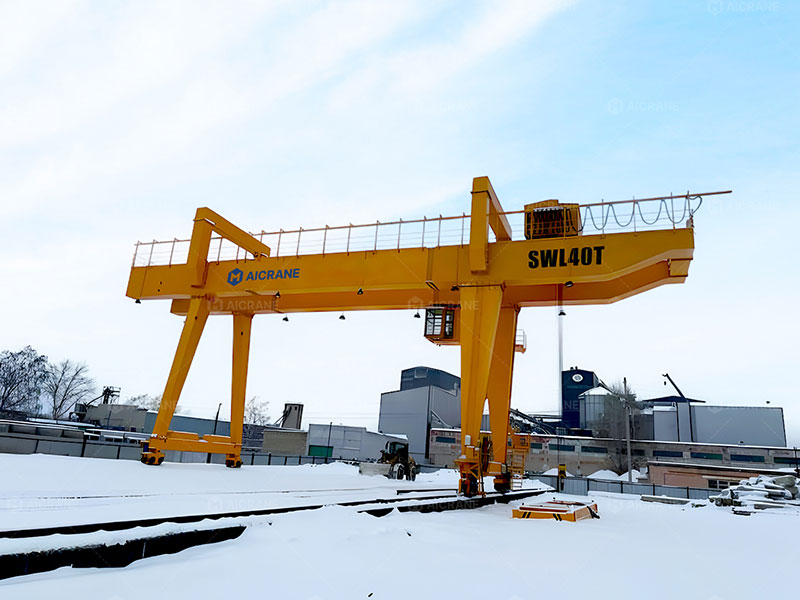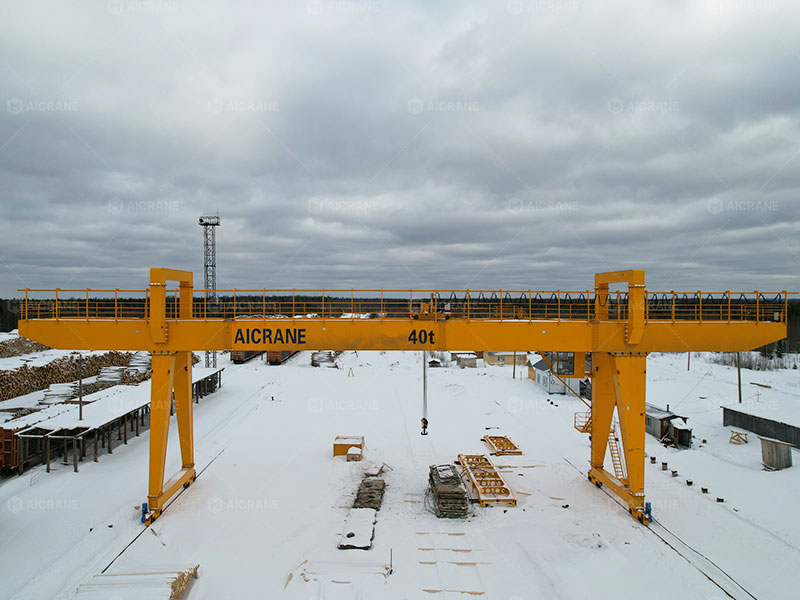When designing a 40 ton gantry crane, one of the important considerations is whether to include a cantilever structure. The cantilever, essentially an extension of the crane girder beyond the supporting legs, may seem like a small structural detail, but it significantly affects the crane’s functionality, installation layout, and operational flexibility. This article explores the purpose of cantilever design, the situations in which it becomes essential, and the benefits and limitations it brings to 40 ton gantry crane applications.

Understanding Cantilever in Gantry Cranes
A cantilever in a 40 ton gantry crane refers to the portion of the girder that extends outward beyond the support legs. This design enables the crane to lift and move loads outside the span of the supporting rails. While not every gantry crane requires a cantilever, it is a practical solution in cases where extended outreach or special loading conditions exist.
In a 40 ton gantry crane, the decision to adopt a cantilever is driven by balancing the heavy lifting capacity with operational space requirements. The structural design must ensure that the extended section does not compromise overall stability or safety.
Why Cantilever Design Is Considered
There are several reasons why engineers and operators choose a cantilever design for 40 ton gantry cranes:
1. Loading and Unloading Beyond Rail Tracks
In many facilities, rail tracks that guide the gantry crane are laid within a confined area. However, trucks, rail wagons, or storage zones may lie outside this span. A cantilever design allows the crane to extend its reach beyond the rails, enabling smooth loading and unloading without repositioning vehicles or cargo manually.
2. Maximizing Yard Utilization
Space efficiency is a critical consideration in heavy industries such as steel fabrication, precast concrete, or container handling. A 40 ton gantry crane with a cantilever can make use of otherwise inaccessible areas, allowing better storage layouts and reducing the need for additional handling equipment.
3. Integration with Adjacent Equipment
Cantilevers are especially useful when cranes need to coordinate with conveyors, production lines, or dockside operations. By extending over fixed installations, the cantilever gantry crane can directly transfer loads, reducing handling time.
4. Avoiding Structural Obstructions
In some work environments, buildings, support columns, or machinery may limit the crane’s movement. A cantilever extension allows the crane to work around these obstacles while still covering the required lifting zone.

Structural Considerations for a 40 Ton Cantilever Crane
Designing a cantilever for a 40 ton gantry crane is not a simple task. Engineers must carefully calculate the structural load distribution and ensure safety factors are adequately met.
1. Load Distribution and Stability
When a 40 ton load is lifted at the end of a cantilever, the structural stresses on the girder, legs, and rail tracks increase significantly. The crane must be designed with reinforced girders, high-strength steel, and appropriate wheelbases to maintain stability.
2. Deflection Control
Cantilevered girders are more prone to deflection compared to standard girders. Excessive deflection can lead to unsafe operations, increased wear, and misalignment. Engineers often use box-type girder construction, which provides higher stiffness and reduced deflection.
3. Rail and Foundation Strength
The rail system and supporting foundation must be designed to withstand uneven load distribution when the crane operates at its cantilever. Stronger rails and deeper foundations are often required for 40 ton applications.
4. Safety Margins and Work Duty
Cantilever cranes usually operate under higher stress conditions. To ensure safety, the design must align with international standards such as FEM, CMAA, or ISO, incorporating higher safety margins, especially for cranes with a heavy duty classification (A5–A7).
When Is Cantilever Design Necessary for 40 Ton Gantry Cranes?
Not all operations require cantilever extensions. In fact, in some cases, a standard full-span double girder gantry crane may be sufficient. However, cantilever design becomes necessary in the following situations:
-
Handling containers in ports or rail terminals where trucks and trains park outside the crane span.
-
Steel coil or heavy material storage yards where materials must be stacked beyond the rail boundary.
-
Shipbuilding and marine applications where the crane must reach over docks or vessels.
-
Manufacturing plants with limited floor space where maximizing every square meter is crucial.
-
Projects requiring integration with existing conveyor belts, furnaces, or assembly lines.
If your operation consistently involves transferring loads from inside the span to areas beyond the rail, a cantilever design is not only beneficial but almost mandatory.
Benefits of Cantilever Design in 40 Ton Gantry Cranes
-
Increased Operational Flexibility – Operators can work outside the main span, reducing restrictions.
-
Improved Material Flow – Direct transfer of loads between cranes, vehicles, and storage areas enhances workflow efficiency.
-
Better Yard Utilization – Cantilevers open up additional space without needing to expand rail tracks.
-
Reduced Equipment Needs – Eliminates the need for forklifts or auxiliary cranes to cover inaccessible areas.
Limitations and Challenges
While beneficial, cantilever designs also bring some challenges that must be addressed:
-
Higher Structural Cost – Requires stronger girders, reinforcement, and foundations.
-
Complex Engineering – Stress calculations and deflection control are more demanding.
-
Maintenance Considerations – Cantilever sections are subject to higher fatigue and wear.
-
Safety Risks if Misused – Overloading the cantilevered area can cause structural instability.
For these reasons, cantilever cranes must be carefully engineered, and operators must be trained to follow strict load-handling protocols.
Case Example: 40 Ton Gantry Crane with Dual Cantilevers
In some heavy industrial yards, 40 ton gantry cranes are designed with dual cantilevers – extensions on both ends of the girder. This allows operators to simultaneously load trucks on one side and stockpile materials on the other. While more expensive, this configuration significantly increases operational throughput and is widely used in steel plants and logistics hubs.
Conclusion
Cantilever design in 40 ton gantry cranes is not just an optional feature – it is a strategic solution for industries where extended reach, space efficiency, and integration with adjacent operations are essential. By allowing cranes to work beyond their rail span, cantilevers improve yard utilization, streamline workflows, and reduce reliance on additional handling equipment.
However, the decision to include a cantilever must be supported by careful structural engineering and cost-benefit analysis. While it adds to the complexity and cost of gantry crane, in many cases, the operational advantages far outweigh these challenges. For businesses dealing with heavy materials, containers, or specialized layouts, a cantilever-equipped 40 ton gantry crane can provide the efficiency, flexibility, and long-term value needed to stay competitive.